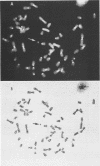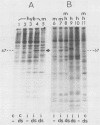Abstract
Human/mouse somatic cell hybrids with chromosome 21 as the only detectable human genetic material were sensitive to both human leukocyte and fibroblast interferons. The presence of additional human chromosomes decreased the amount of interferon needed to attain a given level of virus resistance. Decreased cytopathic effects, decreased virus yields, and the appearance of a specific phosphorylated protein associated with interferon treatment were all observed in hybrids maintaining only human chromosome 21. The phosphorylated protein found in extracts of these human interferon-treated hybrid cells was of mouse origin.
Full text
PDF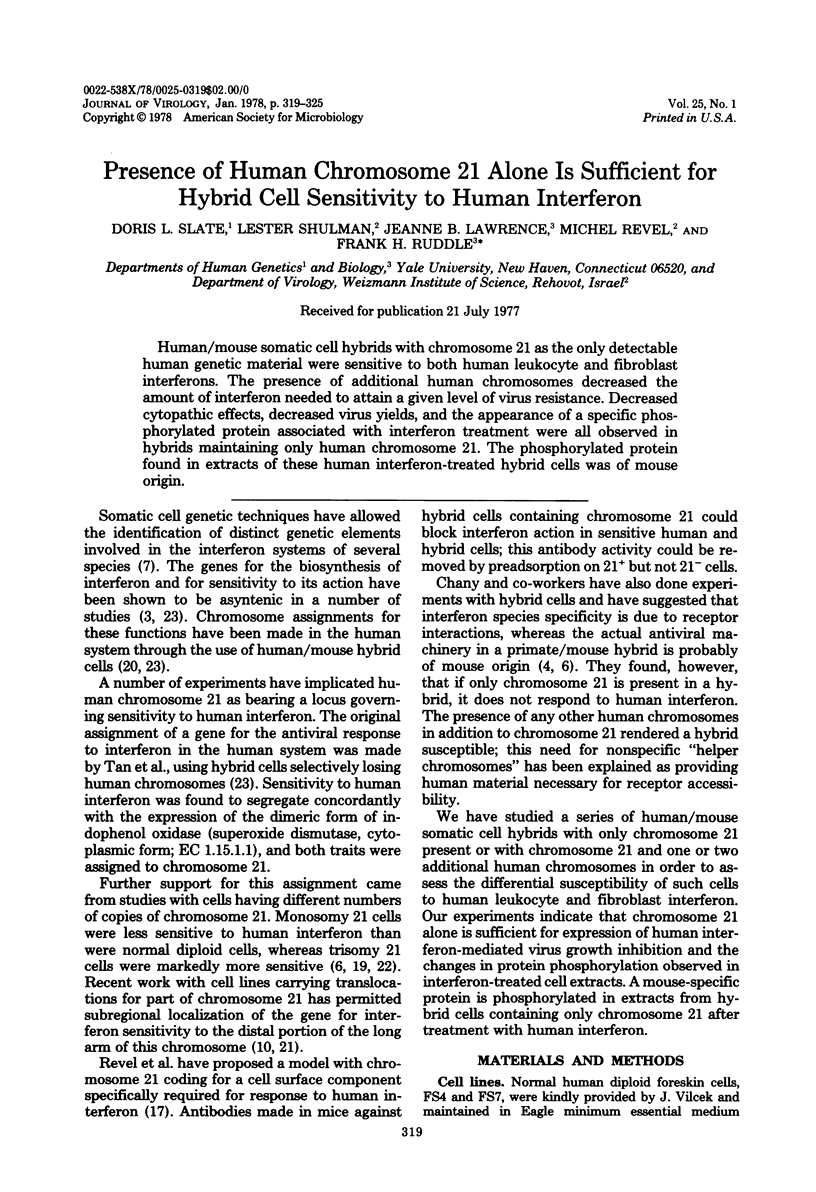
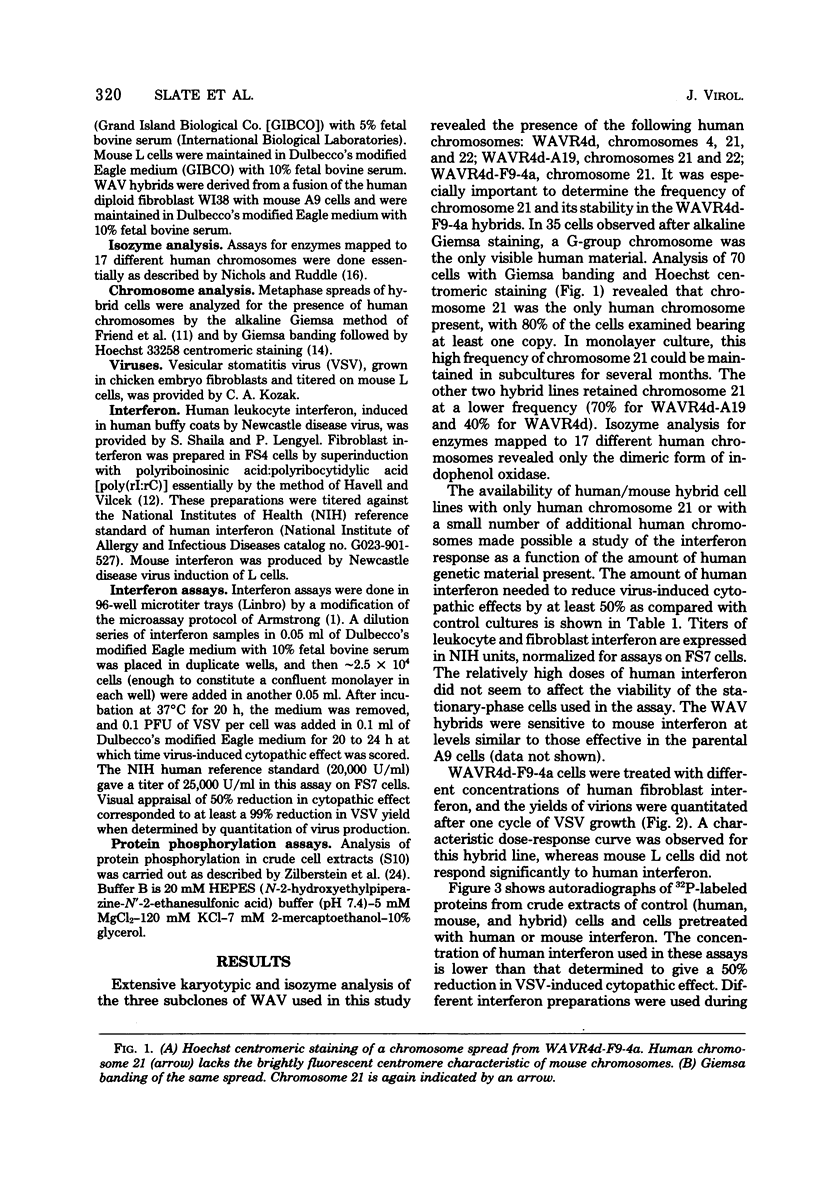
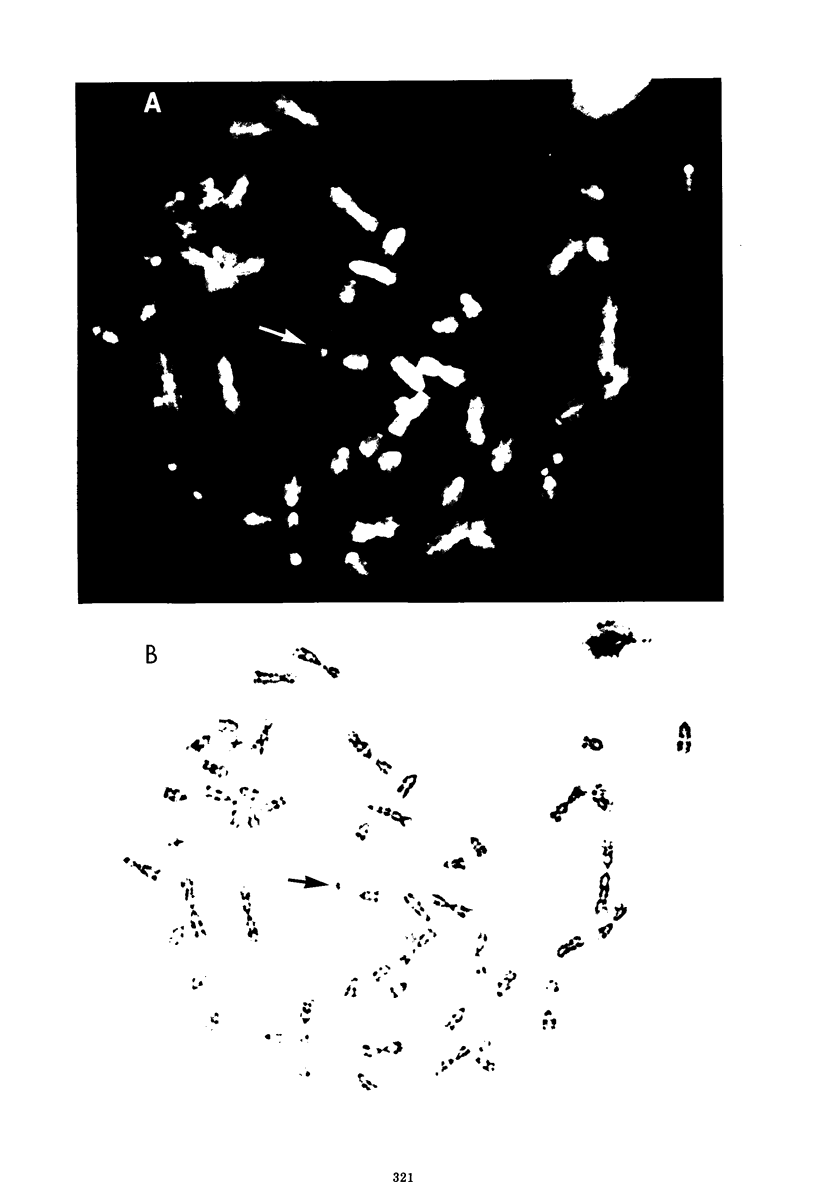
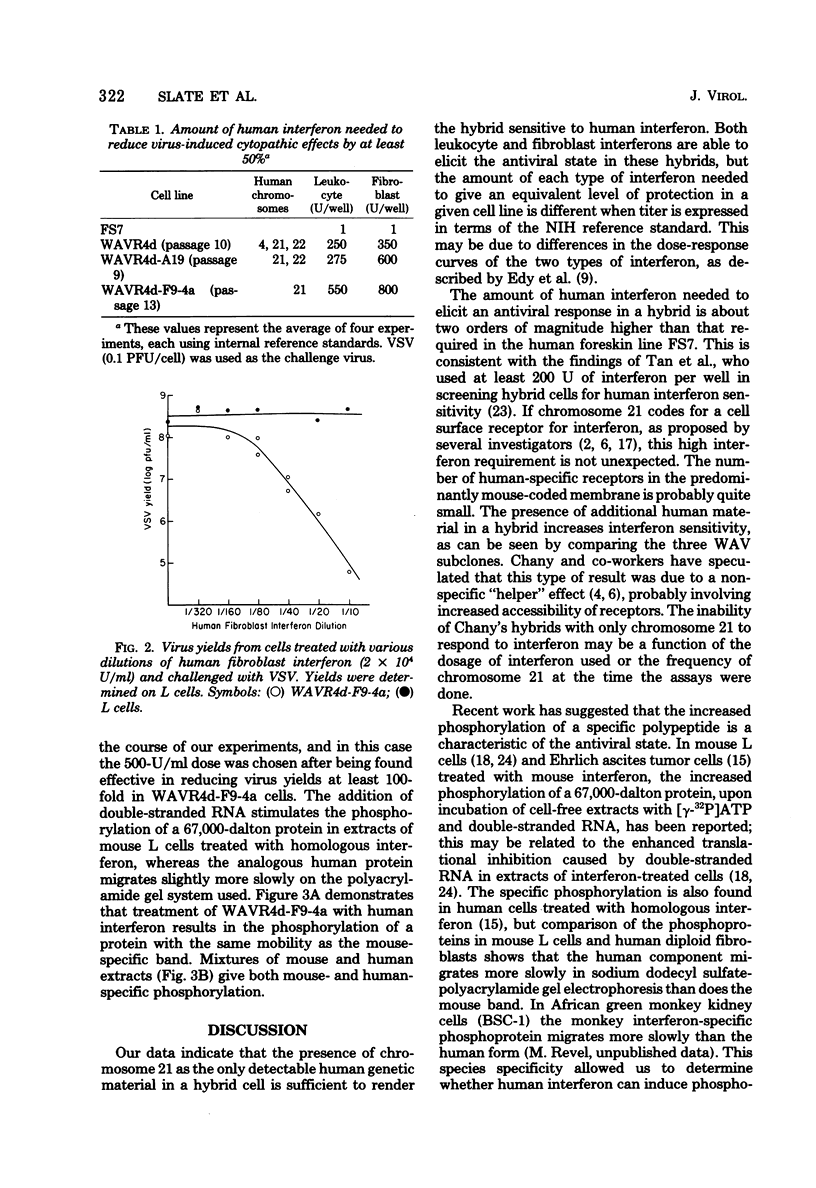
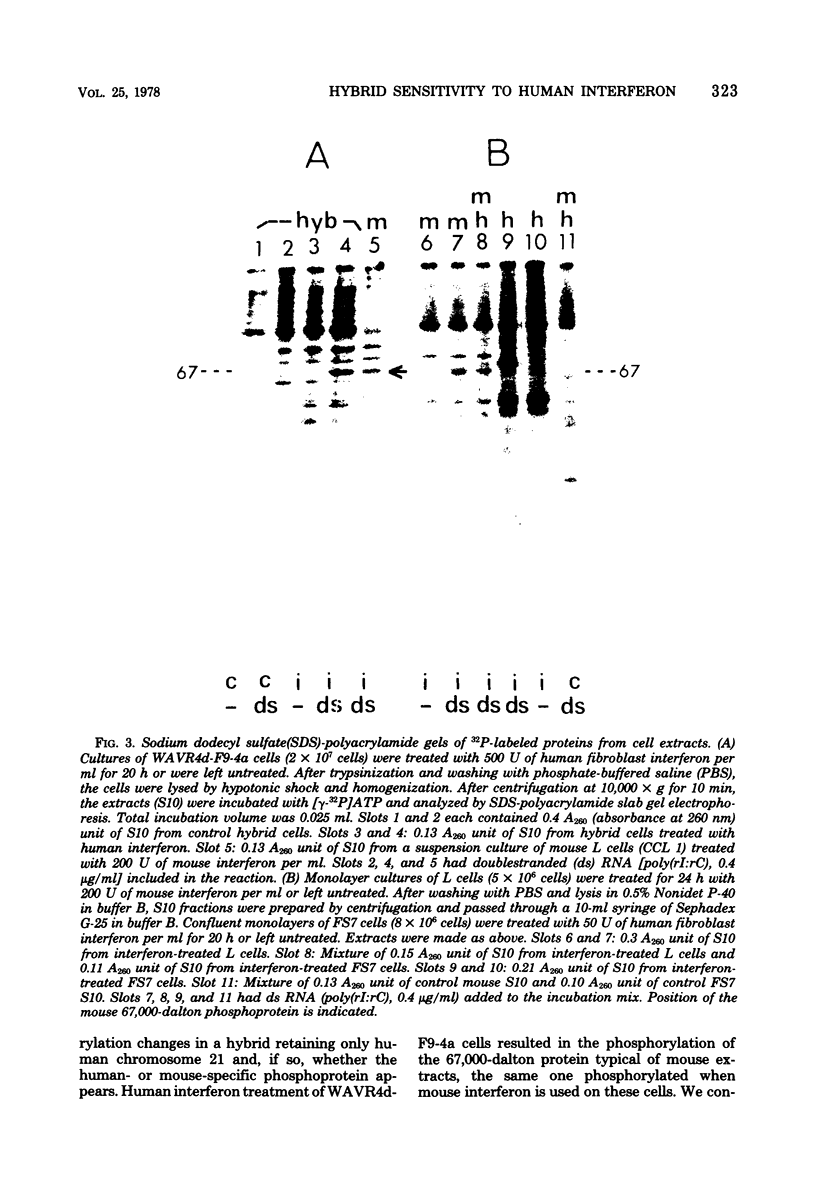
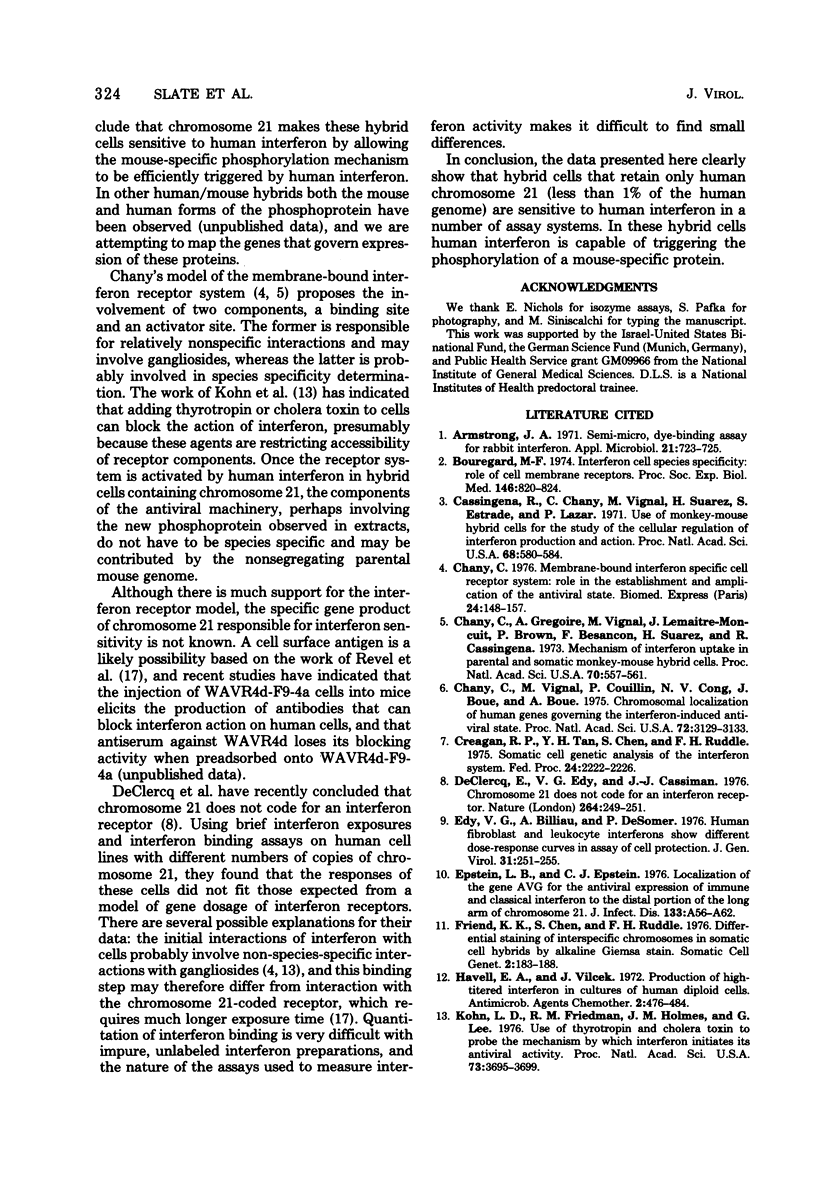
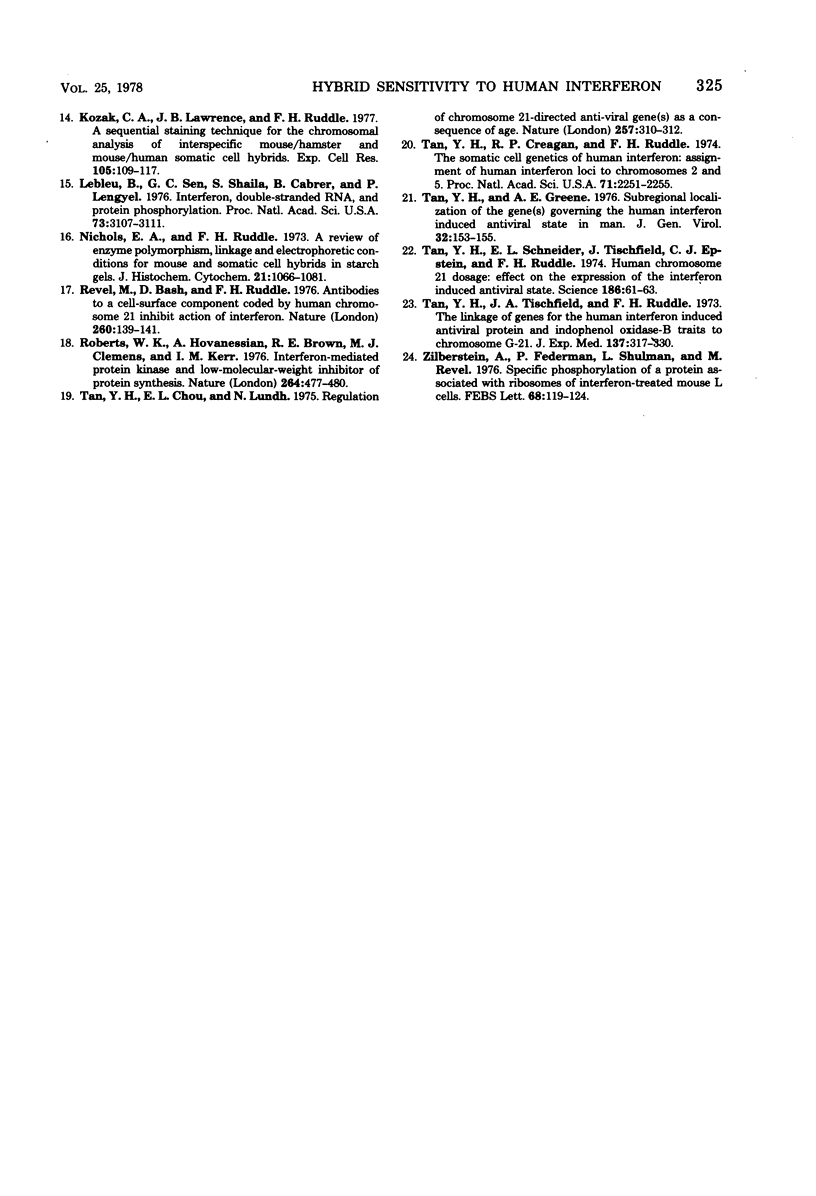
Images in this article
Selected References
These references are in PubMed. This may not be the complete list of references from this article.
- Armstrong J. A. Semi-micro, dye-binding assay for rabbit interferon. Appl Microbiol. 1971 Apr;21(4):723–725. doi: 10.1128/am.21.4.723-725.1971. [DOI] [PMC free article] [PubMed] [Google Scholar]
- Bourgeade M. F. Interferon cell species specificity: role of cell membrane receptors. Proc Soc Exp Biol Med. 1974 Jul;146(3):820–824. doi: 10.3181/00379727-146-38198. [DOI] [PubMed] [Google Scholar]
- Cassingena R., Chany C., Vignal M., Suarez H., Estrade S., Lazar P. Use of monkey-mouse hybrid cells for the study of the cellular regualtion of interferon production and action. Proc Natl Acad Sci U S A. 1971 Mar;68(3):580–584. doi: 10.1073/pnas.68.3.580. [DOI] [PMC free article] [PubMed] [Google Scholar]
- Chany C., Grégoire A., Vignal M., Lemaitre-Moncuit J., Brown P., Besançon F., Suarez H., Cassingena R. Mechanism of interferon uptake in parental and somatic monkey-mouse hybrid cells. Proc Natl Acad Sci U S A. 1973 Feb;70(2):557–561. doi: 10.1073/pnas.70.2.557. [DOI] [PMC free article] [PubMed] [Google Scholar]
- Chany C. Membrane-bound interferon specific cell receptor system: role in the establishment and amplification of the antiviral state. Biomedicine. 1976 Jun;24(3):148–157. [PubMed] [Google Scholar]
- Chany C., Vignal M., Couillin P., Van Cong N., Boué J., Boué A. Chromosomal localization of human genes governing the interferon-induced antiviral state. Proc Natl Acad Sci U S A. 1975 Aug;72(8):3129–3133. doi: 10.1073/pnas.72.8.3129. [DOI] [PMC free article] [PubMed] [Google Scholar]
- Creagan R. P., Tan Y. H., Chen S., Ruddle F. H. Somatic cell genetic analysis of the interferon system. Fed Proc. 1975 Dec;34(13):2222–2226. [PubMed] [Google Scholar]
- De Clercq E., Edy V. G., Cassiman J. J. Chromosome 21 does not code for an interferon receptor. Nature. 1976 Nov 18;264(5583):249–251. doi: 10.1038/264249a0. [DOI] [PubMed] [Google Scholar]
- Edy V. G., Billiau A., De Somer P. Human fibroblast and leukocyte interferons show different dose-response curves in assay of cell protection. J Gen Virol. 1976 May;31(2):251–255. doi: 10.1099/0022-1317-31-2-251. [DOI] [PubMed] [Google Scholar]
- Epstein L. B., Epstein C. J. Localization fo the gene AVG for the antiviral expression of immune and classical interferon to the distal portion of the long arm of chromosome 21. J Infect Dis. 1976 Jun;133 (Suppl):A56–A62. doi: 10.1093/infdis/133.supplement_2.a56. [DOI] [PubMed] [Google Scholar]
- Friend K. K., Chen S., Ruddle F. H. Differential staining of interspecific chromosomes in somatic cell hybrids by alkaline Giemsa stain. Somatic Cell Genet. 1976 Mar;2(2):183–188. doi: 10.1007/BF01542631. [DOI] [PubMed] [Google Scholar]
- Havell E. A., Vilcek J. Production of high-titered interferon in cultures of human diploid cells. Antimicrob Agents Chemother. 1972 Dec;2(6):476–484. doi: 10.1128/aac.2.6.476. [DOI] [PMC free article] [PubMed] [Google Scholar]
- Kohn L. D., Friedman R. M., Holmes J. M., Lee G. Use of thyrotropin and cholera toxin to probe the mechanism by which interferon initiates its antiviral activity. Proc Natl Acad Sci U S A. 1976 Oct;73(10):3695–3699. doi: 10.1073/pnas.73.10.3695. [DOI] [PMC free article] [PubMed] [Google Scholar]
- Kozak C. A., Lawrence J. B., Ruddle F. H. A sequential staining technique for the chromosomal analysis of the interspecific mouse/hamster and mouse/human somatic cell hybrids. Exp Cell Res. 1977 Mar 1;105(1):109–117. doi: 10.1016/0014-4827(77)90156-2. [DOI] [PubMed] [Google Scholar]
- Lebleu B., Sen G. C., Shaila S., Cabrer B., Lengyel P. Interferon, double-stranded RNA, and protein phosphorylation. Proc Natl Acad Sci U S A. 1976 Sep;73(9):3107–3111. doi: 10.1073/pnas.73.9.3107. [DOI] [PMC free article] [PubMed] [Google Scholar]
- Nichols E. A., Ruddle F. H. A review of enzyme polymorphism, linkage and electrophoretic conditions for mouse and somatic cell hybrids in starch gels. J Histochem Cytochem. 1973 Dec;21(12):1066–1081. doi: 10.1177/21.12.1066. [DOI] [PubMed] [Google Scholar]
- Revel M., Bash D., Ruddle F. H. Antibodies to a cell-surface component coded by human chromosome 21 inhibit action of interferon. Nature. 1976 Mar 11;260(5547):139–141. doi: 10.1038/260139a0. [DOI] [PubMed] [Google Scholar]
- Roberts W. K., Hovanessian A., Brown R. E., Clemens M. J., Kerr I. M. Interferon-mediated protein kinase and low-molecular-weight inhibitor of protein synthesis. Nature. 1976 Dec 2;264(5585):477–480. doi: 10.1038/264477a0. [DOI] [PubMed] [Google Scholar]
- Tan Y. H., Chou E. L., Lundh N. Regulation of chromosome 21-directed anti-viral gene(s) as a consequence of age. Nature. 1975 Sep 25;257(5524):310–312. doi: 10.1038/257310a0. [DOI] [PubMed] [Google Scholar]
- Tan Y. H., Creagan R. P., Ruddle F. H. The somatic cell genetics of human interferon: assignment of human interferon loci to chromosomes 2 and 5. Proc Natl Acad Sci U S A. 1974 Jun;71(6):2251–2255. doi: 10.1073/pnas.71.6.2251. [DOI] [PMC free article] [PubMed] [Google Scholar]
- Tan Y. H., Greene A. E. Subregional localization of the gene(s) governing the human interferon induced antiviral state in man. J Gen Virol. 1976 Jul;32(1):153–155. doi: 10.1099/0022-1317-32-1-153. [DOI] [PubMed] [Google Scholar]
- Tan Y. H., Schneider E. L., Tischfield J., Epstein C. J., Ruddle F. H. Human chromosome 21 dosage: effect on the expression of the interferon induced antiviral state. Science. 1974 Oct 4;186(4158):61–63. doi: 10.1126/science.186.4158.61. [DOI] [PubMed] [Google Scholar]
- Tan Y. H., Tischfield J., Ruddle F. H. The linkage of genes for the human interferon-induced antiviral protein and indophenol oxidase-B traits to chromosome G-21. J Exp Med. 1973 Feb 1;137(2):317–330. doi: 10.1084/jem.137.2.317. [DOI] [PMC free article] [PubMed] [Google Scholar]
- Zilberstein A., Federman P., Shulman L., Revel M. Specific phosphorylation in vitro of a protein associated with ribosomes of interferon-treated mouse L cells. FEBS Lett. 1976 Sep 15;68(1):119–124. doi: 10.1016/0014-5793(76)80418-8. [DOI] [PubMed] [Google Scholar]



